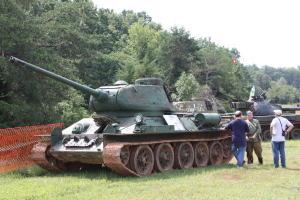|
Get
to know your VMMV staff & vehicles
In
this section we introduce you to the people and armor of the
Virginia Museum of Military Vehicles. We will chat with the
VMMV staff, so that you can get to know the people who "keep
'em running" and work so hard behind the scenes. And also
provide a behind-the-scenes look into the history of individual
vehicles in the VMMV collection. In this, our seventeenth newsletter,
we will answer one of the most oft-asked questions of VMMV…."Where
do you get these wonderful vehicles?"
VMMV
has Triplets
Earlier this year, VMMV acquired three M-35A3 trucks from a
government surplus equipment auction. Each year, the US government
liquidates literally billions of tons of material, including
items the Department of Defense has deemed surplus to their
current warfighting needs. The items go to the highest bidder,
and range from as small as pencils, to demilitarized nuclear-powered
submarines being sold for scrap.
VMMV
purchased the three trucks (more commonly known as "deuce
and halfs,") and after filing the appropriate paperwork,
traveled to the auction site to pick them up. Since the vehicles
are sold "as is," we brought along plenty of spare
parts, extra diesel, oil and tools. After an initial inspection
by VMMV staff for any major problems such as fluid leaks, seized
engines etc, we jumped into the cab, turned the starter switch
and held our breath to see if the engine would come to life.
Each Caterpillar turbocharged diesel roared immediately along
with a shout of approval from the VMMV mechanics.
After
bringing the three deuce and halfs back to VMMV, we did a complete
top-to-bottom inspection to determine what, if anything, needed
to be repaired prior to use. The trucks were in excellent overall
condition, so only a light refurbishment was needed along with
a fresh coat of paint. VMMV staff and volunteers spent time
fixing a few components, sanding, and treating minor rust spots…as
you can see below, when we work, we work hard and sparks fly!!!!
In the
end I think you will agree the three M-35A3 trucks turned out
superbly and are a fine addition to VMMV's stable of military
vehicles.

More
on the M-35A3
The M-35 series of trucks were first fielded by the US in the
1950s and have served in every conflict since. The M-35 is a
6x6 truck capable of carrying 5,000 pounds of cargo off-road
and can travel up to 55 mph on a paved road. In the mid-1990s,
the US Army began a service extension program wherein older
M-35 series vehicles received a new front end-new engine, automatic
transmission, improved driver ergonomics and a central tire
inflation system. The M-35A3 has since been replaced by the
"Family of Medium Tactical Vehicles."
|
|
From
the Files of VMMV......
In this section, we will examine historical records and files
on armor in World War II from the perspective of the British
liaison office to the US War Department. Some of this correspondence
discusses the capabilities and performance of US armor, other
files are the British view of German armor, reflecting their
understanding of the technical capabilities of the panzers they
faced. VMMV is proud to be the custodian of these historical
treasures and wishes to thank Mr. Peter Upton for donating his
father's war time papers.
These
files represent the actual understanding of the Allies of German
armored fighting vehicles and represent a critical link between
the myths and propaganda of both sides and the post-war technical
exploitation. Some of the data may be incorrect or missing,
represent critical intelligence that was unknown to the Allies
at the time. You the reader are presented with the data in raw
form to allow you to see the ground truth of Allied intelligence.
In our
sixth installment, we will continue to examine several documents
associated with the Panzerkampfwagen V or PzKw V…more commonly
known as the "Panther." Because of the large number
of documents, we will break up the Panther file over several
newsletters.
We start
with probably one of the most interesting documents on a little
known facet of Panther history…the use of older turrets
as a pillbox in fixed fortification.
Note,
click on pictures for larger view
Next
is a line drawing showing the relative armor thickness and slope
of the Panther Ausf. G.

And we
close out this segment with a "mutli-view" of the
Panther Ausf. G
|
|
VMMV
Acronym
The lexicon of armored vehicles is filling with a bewildering
amount of acronyms. And at VMMV we have a few of our own. Here
we will have the VMMV word of the day so you may better understand
the conversations you might overhear at the museum.
Tank:
The origin of the word "tank" to describe the modern
turreted main battle tank is owed to the British and their desire
to keep the new vehicle a secret in 1915. A revolutionary weapon
was required to break the stalemated trench-fighting on the
Western Front and the need to keep the new, potentially war-winning
weapon a secret was paramount. While historians have differing
views on the precise origin of the word, they generally agree
that the word "tank" arose from a shortened version
of the innocuous term--water tank-which was the original cover
name for the tracked fighting vehicle being built in the British
factories.
|























